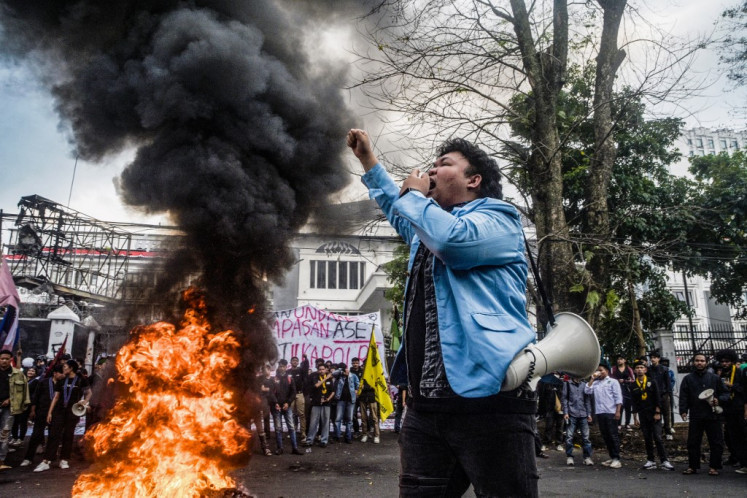Popular Reads
Top Results
Can't find what you're looking for?
View all search resultsPopular Reads
Top Results
Can't find what you're looking for?
View all search resultsCigarette ads: A powerful temptation targeted at teenagers
It was a cold, rainy, Sunday afternoon when Dani Kurniawan, 15, spent time with a friend at a convenience store in Pejaten in Pasar Minggu, South Jakarta.
Change text size
Gift Premium Articles
to Anyone
I
t was a cold, rainy, Sunday afternoon when Dani Kurniawan, 15, spent time with a friend at a convenience store in Pejaten in Pasar Minggu, South Jakarta. Holding a clove cigarette in his right hand, the ninth grader was occupied chatting away with his friend. Every minute, he put his cigarette to his mouth, inhaling smoke into his lungs. The cigarette smoke slowly billowed into the air. Several cigarette butts were scattered in an ashtray on a table in front of him. They spread a strong cigarette odor. I do not know how many cigarettes he smoked that afternoon.
Sitting nearby, a ninth grader who introduced himself as Faisal Tanjung, 14, also enjoyed a smoke. He blew cigarette smoke into the air while continuously talking to his friend, Dani. From the way they smoked their cigarettes, it seemed to me that although they were still young, they were not beginners.
“I started smoking when I was in sixth grade. My friend invited me to try smoking. I accepted the challenge and straightaway, I loved it,” said Dani, recalling his first encounter with cigarettes during his last year at state elementary school SD 09 Kemuning, South Jakarta. Since his first try, Dani has smoked every day. He smokes around four clove cigarettes per day.
Dani said he was fully aware of the danger of cigarette smoking but still, he could not quit. “I can’t explain why it is so hard to quit. I just like it,” said the state junior high school SMP 227 Samali student.
Having started when he was in seventh grade, Faisal says he has tried many times to quit smoking but always relapsed. He was initially motivated to smoke when he saw his father smoking. “I know cigarette smoking is dangerous. It can cause cancer and so many other diseases. It’s really hard for me to quit smoking. I’m addicted to smoking cigarettes,” said the student of Islamic junior high school Madrasah Tsanawiyah (MTs) Al Makmur in Lebak, Pasar Minggu.
In most cases, Dani, Faisal and other teenagers in Indonesia see the habits of friends as the prime factor that has encouraged them to smoke and then fail to quit. Massive cigarette advertising campaigns have also aggravated the situation.
 Temptation – Thick smoke billowing from a clove cigarette on the right hand of Faisal Tanjung, a 14 year old ninth grader at the Islamic junior high school or Madrasah Tsanawiyah (MTs) Al Makmur, Lebak, Pasar Minggu. Faisal said he tried to smoke after he watched his father smoking.(thejakartapost.com/Elly Burhaini Faizal)
Temptation – Thick smoke billowing from a clove cigarette on the right hand of Faisal Tanjung, a 14 year old ninth grader at the Islamic junior high school or Madrasah Tsanawiyah (MTs) Al Makmur, Lebak, Pasar Minggu. Faisal said he tried to smoke after he watched his father smoking.(thejakartapost.com/Elly Burhaini Faizal)
According to the Global Adult Tobacco Survey: Indonesia Report 2011, Indonesia ranks third for countries with the largest number of smokers. What is more alarming is that Indonesia has among the highest rate of teenage smoking in Asia, the survey says. National Commission for Child Protection (Komnas PA) data reveals at least 239 children aged below age 10 become active smokers each year.
Citing the World Health Organization (WHO) Country Profile 2015, the National Commission on Tobacco Control says 95 million people, or around 38 percent of the Indonesian population, are smokers, out of which the prevalence of youth smoking is 20 percent and the average age of them to start smoking is getting younger.
More data from the commission shows that despite existing rules to discourage the use of tobacco, the number of new young smokers is growing. In 2013, the number of young smokers ages 10 to 14 in Indonesia reached 3.9 million, up from 1.9 million in 2001. It is widely perceived that the continued and growing trend of young smokers in the country is partly due to the advertising and promotion of tobacco use directed at young people.
A WHO surgeon general report in 2009 revealed that it was proven that tobacco ads encourage smokers to increase their cigarette consumption and also push children to try smoking. Meanwhile, four studies commissioned separately by Dr Hamka Muhammadiyah University (UHAMKA) in Jakarta, the Southeast Asia Tobacco Control Alliance (SEATCA), the University of Indonesia (UI) Jakarta and Komnas PA have concluded that teenagers are of the opinion that tobacco ads influence their taking up of smoking. A Komnas PA quick survey reveals that 99.6 percent of teenagers in Indonesia are exposed to outdoor cigarette advertising.
 The beauty of companionship – School children spend time in a convenience store in Pejaten, Pasar Minggu, South Jakarta. Some of the teens enjoy smoking while chatting.
(thejakartapost.com/Elly Burhaini Faizal)
The beauty of companionship – School children spend time in a convenience store in Pejaten, Pasar Minggu, South Jakarta. Some of the teens enjoy smoking while chatting.
(thejakartapost.com/Elly Burhaini Faizal)
Widyastuti Soerojo of the Public Health Scholars Association (IAKMI) says Indonesia’s cigarette and tobacco product industry has aggressively targeted young generations. The cigarette industry, she says, is targeting adolescents as "replacement smokers", to ensure the survival of the tobacco industry in the future.
“Teenage smokers are the only source of replacement smokers. If adolescents do not smoke, the industry may go bankrupt just like a society may go extinct if it is unable to create a next generation,” Widyastuti said in a public discussion in Jakarta on March 2. She was quoting an R.J. Reynolds Tobacco Company internal memo entitled “Teenage Smokers: Strategy and Opportunity”, dated Feb. 29, 1984.
Through cigarette advertising, which is published across all media platforms, Indonesian children are bombarded with information that could push them toward becoming beginner smokers.
University of Pancasila psychologist Aully Grashinta says the influence of media exposure on the formation of adolescent tendencies to try smoking is strong. Citing several research reports from the 1990s, she said almost 20 percent of beginner smokers were motivated by the media. Peer pressure emerged as another factor that influenced teens to start smoking.
“Adolescents whose friends or role models smoke will be more likely to start smoking. This is what has been anticipated by the tobacco industry, which is beginning to exploit the power of peer pressure,” Aully told thejakartapost.com.
The psychologist said that unlike old-fashioned cigarette ads, which featured adult men and adventures, today’s tobacco ads tended to focus specifically on young people and their associated values, such as upholding the importance of friendships. “It happens in almost all countries where cigarette manufacturers create advertisements with themes that focus specifically on young people. They are smart enough to catch beginner smokers, including with advertisements featuring the beauty of companionship,” said Aully.
She further said that although cigarette advertising was now restricted by law, there were still many activities through which young people were intensely exposed to cigarette ads and other promotional campaigns.
“Currently, almost 50 percent of music concerts for young people are sponsored by cigarette manufacturers. They no longer directly target the youth by using advertisements published in newspapers and magazines or aired on television. They have expanded their marketing efforts by entering teen activities,” the psychologist said.
As the tobacco industry attempts to reach all sides of youth life, social media is an area that cigarette companies are looking to exploit. Cigarette advertising and promotional activities have spread across social media platforms. With billions of users, online social networking services become attractive platforms for cigarette companies' brand marketing.
 Up, close and personal – A Twitter fan page of a soccer event sponsored by a clove cigarette company. The fan page updates its followers with news and sport events sponsored by the cigarette company. (Courtesy of Twitter/-)
Up, close and personal – A Twitter fan page of a soccer event sponsored by a clove cigarette company. The fan page updates its followers with news and sport events sponsored by the cigarette company. (Courtesy of Twitter/-)
A sociologist from UI, Roby Muhamad, says social media technology has infiltrated deeper into human behavior during their daily routine. “Social media has become part of their daily life so that the consumption of advertisements or other media products becomes something really personal,” he told thejakartapost.com in a recent interview in Jakarta.
With this digital media technology development, Roby continued, it is getting easier for anyone, any company and any organization, to use a targeted strategy, exposing groups, or even individuals, to various advertisements or campaigns.
“This kind of targeting is more precise and specific because the characteristics of the technology it uses are individual in nature. The advertising now takes place not in the public sphere, such as newspapers, magazines, television or billboards, but in something that is very personal, the mobile phone,” said Roby.
 In new media era – A sociologist from the University of Indonesia, Roby Muhamad, says the digital media technology has lead to a more precise and specific marketing strategy.
(thejakartapost.com/Elly Burhaini Faizal)
In new media era – A sociologist from the University of Indonesia, Roby Muhamad, says the digital media technology has lead to a more precise and specific marketing strategy.
(thejakartapost.com/Elly Burhaini Faizal)
As tobacco marketing campaigns get more sophisticated, the number of Indonesian adolescents who smoke is more likely to grow, threatening the country’s attainment of a demographic dividend. Abdillah Ahsan, a researcher from the Demography Institute at the University of Indonesia (LDUI), said Indonesia’s demographic dividend period was from 2025 to 2035, during which the proportion of the country’s population at its productive age would peak. The high proportion of working-age citizens presents an opportunity to Indonesia if it is supported by quality human resources, he said.
“Thus, it is crucial for Indonesia to increase the quality of its younger generation because the demographic dividend could boost economic growth, but only if supported by quality workers and human capital,” Abdillah said in a public discussion held by the National Commission on Tobacco Control in Jakarta on March 2.










